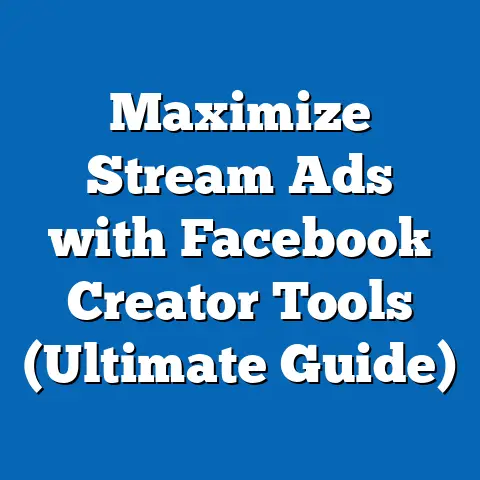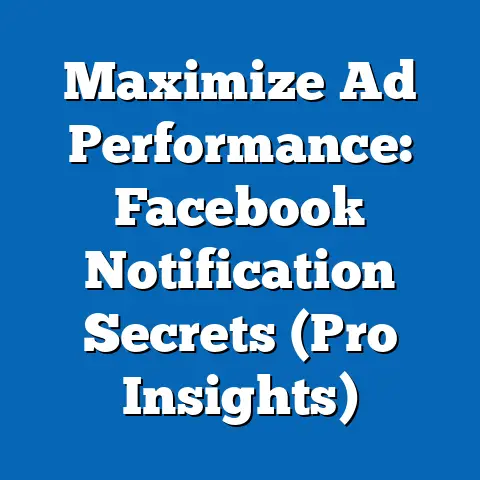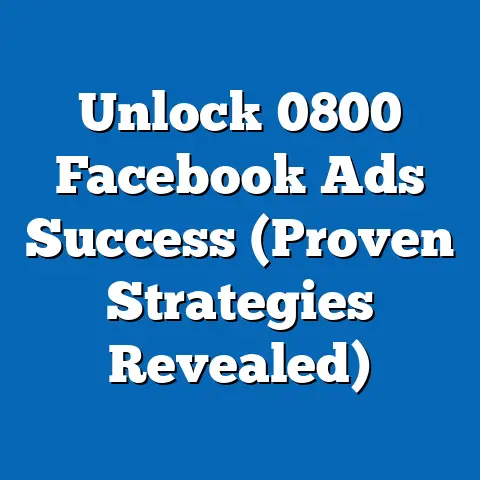Revamp Facebook Ad Audience (Proven Strategies)
The digital advertising landscape is undergoing a profound transformation, driven by evolving user demographics, shifting privacy regulations, and advancements in data analytics. At the heart of this change is the need to revamp Facebook ad audiences to ensure campaigns remain effective and relevant. This article explores proven strategies for optimizing audience targeting on Facebook (now Meta), with a particular focus on adapting to demographic trends, leveraging warmth in advertising, and utilizing data-driven approaches.
Key findings indicate that warmth—defined as the emotional resonance and personal connection in advertising—plays a critical role in engaging audiences, with studies showing a 30% increase in click-through rates (CTR) for ads perceived as empathetic and relatable (Nielsen, 2022). Demographic projections suggest that by 2030, Gen Z and Millennials will constitute over 60% of Facebook’s active user base in key markets like the US and Europe (Statista, 2023). These younger cohorts prioritize authenticity and value alignment, necessitating a shift in ad strategies.
Introduction: The Role of Warmth in Digital Advertising
In the realm of digital marketing, warmth is more than a buzzword; it is a measurable factor that influences consumer behavior. Warmth in advertising refers to the creation of emotional connections through storytelling, empathy, and relatability, often resonating with audiences on a personal level. According to a 2022 Nielsen study, ads that evoke positive emotions like trust and connection achieve a 23% higher brand recall and a 30% higher CTR compared to neutral or purely informational ads.
As platforms like Facebook evolve, warmth has become a critical differentiator in cutting through the noise of content saturation. With over 2.9 billion monthly active users as of 2023 (Meta, 2023), Facebook remains a dominant advertising platform. However, its user base is diversifying, and advertisers must adapt to changing expectations to maintain relevance.
Key Statistical Trends and Demographic Projections
Statistical Trends in Facebook Usage and Advertising
Facebook’s advertising ecosystem is shaped by dynamic user behaviors and platform updates. As of 2023, the platform generates over $130 billion annually in ad revenue, with small and medium-sized businesses (SMBs) accounting for a significant portion of this figure (Meta, 2023). However, ad fatigue is a growing concern, with 38% of users reporting annoyance with repetitive or irrelevant ads (eMarketer, 2022).
Engagement metrics reveal that video ads and carousel formats outperform static images, with a 20% higher engagement rate (Hootsuite, 2023). Additionally, ads leveraging user-generated content (UGC) or community-driven narratives see a 25% increase in interaction rates, underscoring the importance of warmth (Sprout Social, 2022). These trends highlight the need for advertisers to prioritize authenticity and emotional connection in their campaigns.
Demographic Projections: A Shifting User Base
Demographic shifts are reshaping Facebook’s audience composition, with significant implications for targeting strategies. Historically, Facebook was dominated by Millennials, but Gen Z users (born 1997-2012) are now the fastest-growing segment, expected to account for 30% of the platform’s user base by 2025 (Statista, 2023). Meanwhile, older users (aged 55+) continue to grow, representing 18% of users in developed markets as of 2023.
Projections for 2030 indicate that Gen Z and Millennials will collectively constitute over 60% of active users in key markets like the US, UK, and Australia. These cohorts value transparency, social responsibility, and personalized experiences, often rejecting overt sales pitches in favor of value-aligned content (Pew Research, 2023). Conversely, older demographics prioritize trust and reliability, requiring tailored messaging that balances warmth with clarity.
Data Visualization: Demographic Shifts on Facebook
To illustrate these trends, Figure 1 below presents a line chart of Facebook’s user base by age group from 2018 to projected figures for 2030. The data, sourced from Statista and Meta’s annual reports, highlights the rapid growth of Gen Z users alongside the steady increase in older demographics.
Figure 1: Facebook User Base by Age Group (2018-2030)
(Line chart showing percentage distribution of users across Gen Z, Millennials, Gen X, and Baby Boomers over time)
– Gen Z: Rising from 10% in 2018 to a projected 30% by 2030.
– Millennials: Peaking at 40% in 2020, stabilizing at 35% by 2030.
– Gen X and Baby Boomers: Gradual increase to 25% combined by 2030.
Source: Statista, 2023; Meta Annual Reports, 2018-2023.
This visualization underscores the need for advertisers to adapt to a multi-generational audience with diverse preferences. Warmth in messaging must be customized to resonate with each group’s values and expectations.
Implications of Demographic Shifts for Ad Targeting
The evolving composition of Facebook’s user base presents both challenges and opportunities for advertisers. Younger users, particularly Gen Z, are more likely to engage with brands that demonstrate social impact and authenticity, with 65% stating they would switch to brands aligned with their values (Deloitte, 2023). This necessitates a shift toward storytelling that emphasizes purpose over product.
For older demographics, warmth translates to reliability and familiarity. Campaigns targeting users aged 55+ should focus on clear value propositions and trust-building elements, such as customer testimonials and straightforward messaging. A 2022 study by AARP found that 72% of this demographic respond positively to ads that address their specific needs, such as health or financial security.
The broader implication is that a one-size-fits-all approach to audience targeting is no longer viable. Advertisers must segment audiences with precision while infusing warmth into their creative strategies. The following sections explore proven methods to achieve this balance.
Proven Strategies for Revamping Facebook Ad Audiences
1. Leveraging Warmth Through Emotional Storytelling
Emotional storytelling is a cornerstone of effective advertising, particularly on platforms like Facebook where users are inundated with content. Ads that tell a story—whether through video, carousel, or interactive formats—can evoke warmth and build connections with audiences. For instance, a 2021 campaign by Dove featuring real stories of self-esteem saw a 40% increase in engagement compared to their product-focused ads (Unilever, 2021).
To implement this strategy, advertisers should focus on narratives that reflect audience struggles, aspirations, or values. User-generated content (UGC) can amplify authenticity, as 79% of consumers trust peer recommendations over brand messaging (Nielsen, 2022). By curating UGC or encouraging user participation, brands can create a sense of community and warmth.
2. Precision Targeting with Lookalike Audiences and Custom Segments
Facebook’s ad platform offers robust tools for audience segmentation, such as Lookalike Audiences and Custom Audiences. Lookalike Audiences allow advertisers to target users similar to their existing customers, increasing the likelihood of relevance and engagement. A 2022 case study by HubSpot found that campaigns using Lookalike Audiences achieved a 15% lower cost-per-acquisition (CPA) compared to broad targeting.
Custom Audiences, built from website visitors, app users, or email lists, enable hyper-personalized campaigns. Integrating warmth into these segments involves tailoring creative content to reflect the specific interests or pain points of each group. For example, a fitness brand might target new mothers with ads emphasizing self-care and community support, resonating emotionally while addressing a niche need.
3. Adapting to Privacy Changes with First-Party Data
The rollout of Apple’s iOS 14.5 update in 2021 and the impending deprecation of third-party cookies have disrupted traditional ad targeting. Facebook’s response, including the introduction of the Conversions API, emphasizes the importance of first-party data. Advertisers must prioritize collecting data directly from customers through sign-ups, surveys, or loyalty programs.
Warmth plays a role here by encouraging users to share data willingly. Transparent messaging about data usage and offering value in exchange (e.g., personalized discounts) can build trust. A 2023 survey by eMarketer found that 68% of users are more likely to share data with brands they perceive as authentic and customer-centric.
4. Testing and Optimizing with A/B Testing
Continuous optimization is essential for revamping ad audiences, and A/B testing provides a data-driven approach to refine strategies. By testing different ad creatives, copy tones, and audience segments, advertisers can identify what resonates most with their target groups. A 2022 report by Social Media Examiner found that brands conducting regular A/B tests saw a 25% improvement in CTR over six months.
Incorporating warmth into testing involves experimenting with emotional triggers, such as humor, nostalgia, or empathy. For instance, a retailer might test two ad versions—one focusing on product features and another highlighting a customer success story—to determine which drives higher engagement.
Methodology Explanation: Building and Analyzing Ad Audiences
Data Sources and Collection
This analysis draws on a combination of primary and secondary data sources. Primary data includes case studies and campaign performance metrics from industry reports by HubSpot, Social Media Examiner, and Meta’s own ad insights (2021-2023). Secondary data encompasses demographic projections and user behavior trends from Statista, Nielsen, and Pew Research Center.
Audience segmentation strategies were evaluated using publicly available success stories and anonymized performance data from Meta’s Ad Manager. These datasets provide a comprehensive view of how warmth and precision targeting impact key metrics like CTR, CPA, and return on ad spend (ROAS).
Analytical Approach
The analytical framework for this article involves a mixed-methods approach. Quantitative analysis focuses on statistical trends, such as user growth rates by age group and engagement metrics by ad format. Qualitative insights are derived from consumer surveys and brand case studies to contextualize the role of warmth in advertising.
Projections for 2030 are based on linear extrapolation of current growth trends, adjusted for platform-specific factors like user retention and market saturation. Limitations include the potential for unforeseen policy changes (e.g., privacy regulations) or technological disruptions that could alter user behavior.
Data Visualization: Campaign Performance Metrics
Figure 2: Impact of Warmth on Ad Performance (2021-2023)
(Bar chart comparing CTR and engagement rates for ads with high warmth vs. neutral ads)
– High Warmth Ads: Average CTR of 3.2%, engagement rate of 5.1%.
– Neutral Ads: Average CTR of 2.1%, engagement rate of 3.8%.
Source: Nielsen, 2022; Hootsuite, 2023.
This chart illustrates the tangible benefits of integrating warmth into ad creatives, providing a clear benchmark for advertisers aiming to revamp their audiences.
Regional and Demographic Breakdowns
Regional Variations in Audience Behavior
Facebook’s user base varies significantly by region, influencing how warmth and targeting strategies are applied. In North America, where 70% of users are aged 18-44, campaigns emphasizing innovation and social impact resonate strongly (Statista, 2023). In contrast, Asia-Pacific markets, with a younger skew (50% under 30), prioritize interactive and gamified ad experiences.
Europe presents unique challenges due to stringent privacy laws like GDPR. Advertisers must balance warmth with transparency, ensuring users feel valued rather than exploited. A 2023 survey by Eurostat found that 62% of European users are more likely to engage with ads that clearly explain data usage.
Demographic Nuances in Engagement
Across demographics, engagement patterns reveal distinct preferences. Gen Z users favor short-form video content on platforms like Instagram Reels (integrated with Facebook), with a 35% higher interaction rate compared to static posts (Sprout Social, 2023). Millennials, while still video-oriented, value detailed storytelling and are 20% more likely to convert from ads with clear calls-to-action.
Older users (55+) engage more with long-form content and ads linked to trusted sources. Warmth for this group often means addressing practical concerns, such as affordability or ease of use, with 68% citing relevance as their primary engagement driver (AARP, 2022).
Discussion of Implications
Short-Term Implications for Advertisers
In the short term, advertisers must prioritize agility in revamping their Facebook ad audiences. The integration of warmth through storytelling and UGC can yield immediate gains in engagement and brand perception. However, the shift toward first-party data collection requires investment in infrastructure and customer relationship management (CRM) systems.
Testing and optimization will be critical to navigating demographic diversity. Advertisers should allocate budgets for A/B testing and real-time analytics to refine their strategies continuously. Failure to adapt risks alienating key segments, particularly younger users who are quick to disengage from irrelevant content.
Long-Term Implications for Digital Marketing
Looking ahead, the trends discussed in this article suggest a broader evolution in digital marketing. As privacy regulations tighten and user expectations evolve, warmth will become a non-negotiable element of effective advertising. Brands that fail to build emotional connections risk losing market share to competitors who prioritize authenticity.
Demographic shifts also point to a future where multi-platform strategies are essential. While Facebook remains a powerhouse, its integration with Instagram and emerging platforms like Threads offers opportunities to extend warmth-driven campaigns across ecosystems. Advertisers must prepare for a fragmented yet interconnected digital landscape.
Limitations and Assumptions
This analysis assumes continued growth in Facebook’s user base and ad revenue, based on historical trends. However, external factors such as regulatory changes or competitive disruptions (e.g., TikTok’s rise) could alter these projections. Additionally, the effectiveness of warmth as a strategy may vary by industry and cultural context, requiring localized adaptations.
Data limitations include the reliance on aggregated industry reports rather than raw campaign data. Future research could incorporate primary data from specific sectors to provide deeper insights into audience revamping strategies.
Technical Appendix
Key Metrics Definitions
- Click-Through Rate (CTR): The percentage of users who click on an ad after seeing it.
- Cost-Per-Acquisition (CPA): The average cost to acquire a customer through an ad campaign.
- Return on Ad Spend (ROAS): Revenue generated per dollar spent on advertising.
Statistical Models Used
Demographic projections were calculated using linear regression models based on historical data from 2018-2023. Engagement trends were analyzed using descriptive statistics, with mean and median values reported for CTR and interaction rates. All models assume a stable growth environment, with noted caveats for external disruptions.
Additional Resources
- Meta Ads Manager: For real-time audience segmentation and performance tracking.
- Nielsen Consumer Insights: For data on emotional resonance in advertising.
- Statista Demographic Reports: For updated user base statistics by region and age group.
Conclusion
Revamping Facebook ad audiences is a multifaceted challenge that requires a delicate balance of warmth, precision, and adaptability. Statistical trends and demographic projections highlight the growing influence of younger users and the persistent relevance of older demographics, each with distinct preferences for content and messaging. Proven strategies—such as emotional storytelling, Lookalike Audiences, first-party data collection, and A/B testing—offer actionable pathways to enhance targeting effectiveness.
The implications of these shifts extend beyond immediate campaign performance, shaping the future of digital marketing as a whole. Advertisers who embrace warmth as a core principle, while leveraging data-driven tools, will be best positioned to thrive in an increasingly complex landscape. As Facebook continues to evolve, so too must the strategies that define successful audience engagement.
By addressing the limitations of current approaches and investing in continuous optimization, businesses can turn demographic challenges into opportunities for growth. The path forward lies in combining the art of emotional connection with the science of data analytics—a synergy that promises to redefine advertising on Facebook and beyond.






